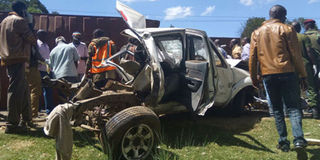Time to get real on road safety in Kenya

A pick up that was involved in the crash at the Sachangwan on December 12, 2017. PHOTO | CAROLINE WAFULA | NATION MEDIA GROUP
What you need to know:
One is the variable standards of driving on Kenyan roads and how many drivers and vehicles fit into the poor to outright dangerous category.
We, Kenyans, have become used to these low standards to the extent of being immune to them but which anyone from a country with better standards will tell you are disgraceful and dangerous.
The traffic regulations in Kenya are clear and laudable but, in many cases, hardly worth the paper they are written on.
It happens especially around this time of the year: A string of gruesome road accidents. It has got so bad that many Kenyans prepare for anything when they embark on a road journey.
None of this really surprises me. Indeed, I am amazed that the injury and death statistics are not higher. A recent trip upcountry brought it home to me.
And it was not just from the comfort of my car; I landed up having to take matatus and the bodas and can certainly say my trip was never dull. I also had several interesting interactions with our traffic police.
The variety of experiences forced me to think hard about road safety in Kenya and why it has a chequered reputation.
I read with more than passing interest the paid advertisement, Joint press statement on road safety during this festive season, from the Inspector-General of Police and the directors-general of NTSA and KeNHA.
COMPLIANCE
Yes, some of the information about short-, medium- and long-term measures was informative in a general sort of way. I chuckled at the phrase: “The National Police Service and the NTSA have beefed up enforcement and patrol teams across the country”. I would agree the former were very visible, particularly on the roads adjacent to police stations.
I’d best describe the various operations as largely going through the motions of being present to enforce compliance to road safety rules. Many drivers were flagged down, especially public service ones.
The statement went into some useful detail about plans to upgrade black spots such as the Kibunja-Salgaa section and dualling of the Nairobi-Nakuru-Mau Summit road.
But anyone reading the statement cannot help but wonder whether it really gets close to the core of the issues at stake. One is the variable standards of driving on Kenyan roads and how many drivers and vehicles fit into the poor to outright dangerous category.
SPEEDING
The speeding and complete disregard of such elementary traffic and safety rules as not overtaking along the solid yellow line was hair-raising. A journey is incomplete without seeing one or two near-misses or drivers being forced off the road by overtaking vehicles.
We, Kenyans, have become used to these low standards to the extent of being immune to them but which anyone from a country with better standards will tell you are disgraceful and dangerous.
Coupled with this is the often questionable roadworthiness of vehicles. I would vouch a large bet on how many vehicles would be declared unroadworthy in a serious, co-ordinated and honest check.
The traffic regulations in Kenya are clear and laudable but, in many cases, hardly worth the paper they are written on. You don’t need a magnifying glass to see that, despite attempts to reform the police, there has been little progress. The National Police Service Reform Programme is a very slow work in progress.
PATCHY MORALE
In a paper, Set up to Fail? Police Reforms in Kenya, Anneke Osse argues that “there is no real incentive for the powers that be to build a truly effective, professional, accountable police service”.
I noticed that, despite numerous police officers, there was inadequate backup and patchy morale. Besides being underpaid, the conditions many junior officers live in and work under are very basic.
Then there are the many accusations of bribery. Whilst I did not experience any, many said it was alive and kicking.
The poor standards of driving and the speeding are clearly evident. Coupled with this is the ineffective or plain lack of enforcement of the traffic laws by the bodies tasked with it.
There lie the other causes of our high accident rate. We cannot just blame the state of our roads per se.
Mr Shaw is a public policy and economic analyst. [email protected].





